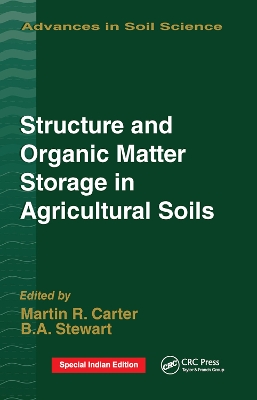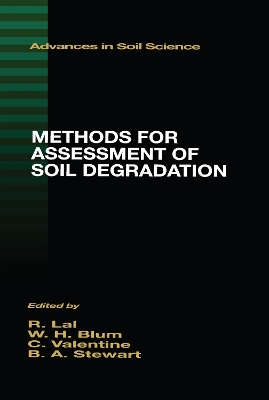Advances in Soil Science
2 primary works • 4 total works
Book 8
Structure and Organic Matter Storage in Agricultural Soils
by M R Carter and B.A. Stewart
Soils comprise the largest pool of terrestrial carbon and therefore are an important component of carbon storage in the biosphere-atmosphere system. Structure and Organic Matter Storage in Agricultural Soils explores the mechanisms and processes involved in the storage and sequestration of carbon in soils. Focusing on agricultural soils - from tropical to semi-arid types - this new book provides an in-depth look at structure, aggregation, and organic matter retention in world soils.
The first two sections of the book introduce readers to the basic issues and scientific concepts, including soil structure, underlying mechanisms and processes, and the importance of agroecosystems as carbon regulators. The third section provides detailed discussions of soil aggregation and organic matter storage under various climates, soil types, and soil management practices. The fourth section addresses current strategies for enhancing organic matter storage in soil, modelling techniques, and measurement methods.
Throughout the book, the importance of the soil structure-organic matter storage relationship is emphasized. Anyone involved in soil science, agriculture, agronomy, plant science, or greenhouse gas and global change studies should understand this relationship. Structure and Organic Matter Storage in Agricultural Soils provides an ideal source of information not only on the soil structure-storage relationship itself, but also on key research efforts and direct applications related to the storage of organic matter in agricultural soils.
Book 9
Methods for Assessment of Soil Degradation
by Rattan Lal, Winfried E. H. Blum, C Valentin, and B.A. Stewart
Nearly two billion people depend on hundreds of millions of smallholder farmers for food security. Yet, these farmers' lives also hang in the balance due to their extreme vulnerability to the risks of soil degradation and depletion, soil exhaustion, climate change, and numerous biotic and abiotic stresses. Soil Management of Smallholder Agriculture explores the potential smallholder agriculture hold for advancing global food security and outlines the challenges to achieving this goal.
The book addresses the challenges and opportunities that resource-poor and small landholders face and provides recommended management practices to alleviate soil-related constraints, and increase and sustain crop yield and production. It discusses the cultural, economic, social, and technological aspects of sustainable soil management for smallholder farmers. It then examines soil-related and institutional constraints, principles of sustainable agriculture, soil quality improvement, nutrient and soil fertility management, soil carbon sequestration, soil security, efficient use of resources, and agronomic production.
Edited by experts, the book makes the case for the adoption of proven technologies of sustainable intensification, producing more from less, both for advancing agronomic production and adapting to changing climate. It outlines a strategy that will usher in a soil-based Green Revolution by increasing the use efficiency of energy-based inputs such as fertilizers, pesticides, and irrigation to restore soil quality, and sequestering carbon in the terrestrial ecosystems. This strategy helps small farms narrow the gap between the actual and attainable crop yield.


